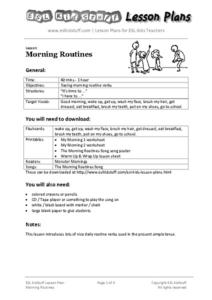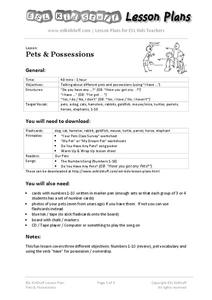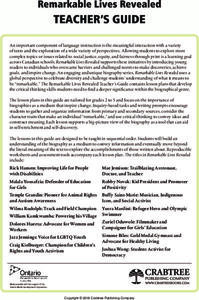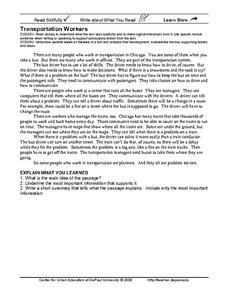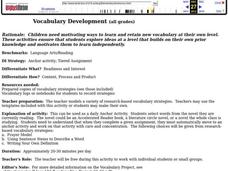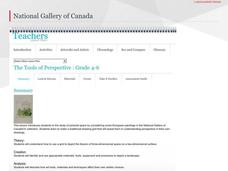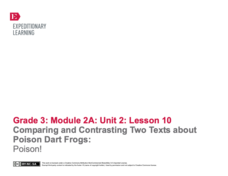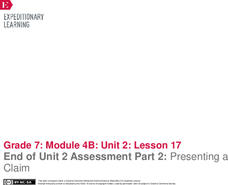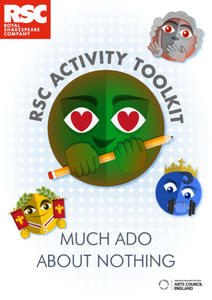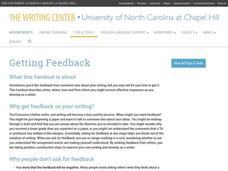Savvas Learning
Clauses
Noun, adverbial, and adjective clauses are the focus of this 26-page grammar packet designed for language learners. Loaded with activities, exercises, games, and worksheets, the materials can be adapted for most levels.
ESL Kid Stuff
Describing People (Adjectives)
As part of a series of lessons focusing on the parts of speech, language learners engage in games and exercises that encourage them to use adjectives to describe people.
ESL Kid Stuff
Morning Routines
Morning routines are the subject of this series of activities designed for language learners. Kids practice crafting questions and responses using the provided morning routine targeted vocabulary words.
ESL Kid Stuff
Numbers 1-20
Language learners engage in a series of games and activities designed to help them recognize and name the numbers from ten to twenty.
ESL Kid Stuff
Adverbs
Run quickly. Walk slowly. Jump high. As part of their study of English parts of speech, language learners engage in a series of activities designed to introduce them to the descriptive power of adverbs.
ESL Kid Stuff
Pets & Possessions
Language learners engage in a series of games and activities using pet vocabulary and the verb "have" to show possession or ownership.
Crabtree Publishing
Remarkable Lives Revealed
Six lessons make up a unit all about biographies. Scholars read about a remarkable life while taking notes and identifying characteristics of the biographical genre. Readers examine the tale's obstacles, accomplishments, and sequence of...
Curated OER
Show, Don't Tell: Details to Make Writing Come Alive
After each of three viewings of a 45-second video, aspiring writers employ vivid adjectives and precise, strong verbs to "show, don't tell." First they compose a single sentence, then three, and finally a five-sentence paragraph. Repeat...
Curated OER
Transportation Workers
Summarizing a text means being able to identify supporting details. Your class can learn about transportation workers in Chicago as they read a one-page informational passage. When they are finished reading they'll explain what they've...
Curated OER
Vocabulary Development
Learners utilize various vocabulary strategies. They use vocabulary logs to record strategies they have been taught, such as the Frayer Model (definition, picture, examples, non-examples), writing their own definitions, and using...
School District of Palm Beach County
Framed Paragraphs characterization, problem and solution, symbolism, conflict
Support your learners as they work on writing paragraphs by providing graphic organizers, outlines, and frames. Sift through this packet to find the perfect organizers and templates to prepare pupils for writing. The resource...
Scholastic
Outlining Main Ideas and Details
Practice outlining and evaluating expository writing in this lesson. After discussing main ideas and seeing examples, young writers go through a sample outline and discuss the way to properly format a piece of writing. They then create...
EdHelper
George Washington's Socks by Elvira Woodruff
A solid, straightforward book report form is an excellent addition to your literature unit. Class members note the main characters, point of view, plot elements, and other important details from a story, adding their favorite part...
Curated OER
Introduction to Age of Absolutism
Who were the absolute monarchs of Europe and what effect did they have on their countries? Young historians begin by naming qualities they believe are important for a monarch to possess. They then take notes on four key factors...
National Gallery of Canada
The Tools of Perspective
Make a study of perspective in the real world. Learners examine and discuss works of art that show examples of perspective before trying their own hands at it. Using a grid drawn on transparent paper, class members transfer a view from a...
EngageNY
Comparing and Contrasting Two Texts about Poison Dart Frogs: Poison!
Scholars compare and contrast two informational texts about Poison Dart Frogs. A brief vocabulary review and discussion lead the way to a two-part close reading—the first reading for gist the second reading for details. Followed by a...
EngageNY
Using Multimedia in Presentations: Preparing to Present Claims
Time to wrap it all up! Using facts, details, and examples, pupils present their claims about whether the American Academy of Pediatrics should increase its screen time recommendations. They incorporate a multimedia visual display and...
EngageNY
End of Unit 2 Assessment Part 2: Presenting a Claim
There's no time like the present for a presentation. Scholars present their claims about water management using facts, details, and examples from their research throughout the unit. Afterward, they complete exit tickets to evaluate their...
Teach-nology
Reading Comprehension: Compare and Contrast
What do a zoo and a farm have in common? Second graders read about each place, and compare and contrast the details using two multiple choice questions.
Royal Shakespeare Company
RSC Activity Toolkit: Much Ado About Nothing
Are you frustrated by searching for activities to engage readers in their study of Much Ado About Nothing? Sigh no more. Young thespians will find much to do in this Royal Shakespeare Company 23-page Toolkit. Included in the sections are...
Hyperion Publishing
Words We Live By: Your Annotated Guide to the Constitution
The language of the Constitution can feel quite ominous to young learners, but there are a variety of strategies you can utilize to help your class grasp the important concepts and ideals in our nation's founding document. This lesson...
University of North Carolina
Getting Feedback
As many writers know, you are your own worst editor. The 10th installment in the Writing the Paper series explains that getting feedback from others is crucial to the writing process. The handout highlights the best time to ask others to...
EngageNY
Citing Evidence: The Ending of Pygmalion
Show time! After completing questions over Pygmalion section nine, scholars perform a reader's theater activity of pages 87-88. They then revisit their Eliza Character Trackers and add details as needed.
EngageNY
Close Reading and Summarizing: The Epilogue of Pygmalion
Moving from what to why. After completing questions over the epilogue of Pygmalion, scholars take a close look at their Eliza Character Trackers and complete part II. They have collected a lot of details about Eliza's character and now...


